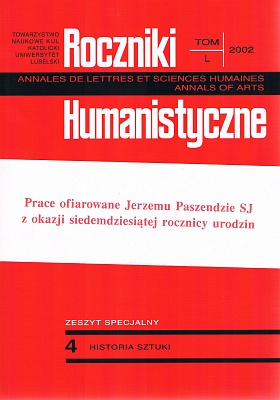Landscapes by Ambroggio da Fossano Called Bergognone. The Meaning of Tradition Within the Painter’s New Composition Solutions
Abstract
Ambroggio da Fossano, a Milan painter, Vincenzo Foppo’s disciple, connected with Carthusia in Pavia, belonged to the leading artists of the Lombardic Renaissance. The subjectmatter of his works was defined by the circles connected with the Sforza court as well as by those in Carthusia. The problem of tradition or innovation that is often raised in the literature concerning the painter often refers to the opposition of the Middle Ages and the Renaissance. Traditionalism in Lombardy derived its contents from the local art of the late Gothic period, and in painting it also introduced elements of the Netherlandic painting that came to Italy via Genoa. However, there are the painter’s original solutions that are concerned both with the contents and the form of his works. The notions of tradition and innovation as terms left by the 14th century history of art did not exist in the court art, especially sponsored by the Sforzas.
Ambroggio’s landscapes reveal three main types of composition, to different degrees referring to the reality of the area, although they are not a truthful record of the landscape.
- Presentation of Carthusia near Pavia that both as a foundation and the mausoleum of the Sforzas’ court is shown in paintings with religious contents, e.g. Christ Carrying the Cross and on the foundation fresco in the apse of the transept in the monastery church Certosa do Pavia. Pictures of the Virgin Mary with Infant present Carthusia in the background, too; it is shown from the side of the monastery’s household buildings. In almost each of the paintings the realism of the presented monastery with the church and palace serves a different meaning that is defined by the foreground of the composition. Carthusia is a foundation document, and by the very fact it is a testimony to the glory of the Sforza family. Carthusia also means the Holy City – Jerusalem that, as a symbolic sign, is directly connected with mystic texts. One of the most important texts that help one understand the pictures painted in the circle of Carthusia is Vita Christi by Ludolf of Saxony that was used by the monks as a subject of meditations and contemplations. Carthusia is also the place where the Virgin Mary with Infant appeared; her cult was developed in the religiousness of the monastery. In such compositions it is a place that visualizes the reality of the monastery household where the symbols devoted to the cult of the Virgin Mary are present.
- Presentation of the city as actual places with the court buildings, the church and the canal, which allows identification with Milan of Ambroggio’s times. They are places selected for events connected with St Ambrose’s life. Also pictures of the Virgin Mary with Infant show the real look of the city that was the main metropolis of the then Europe. However, they are not pictures of a real city but of its chosen fragments with the court or church architecture connected with the Sforzas patronage. But the way space is presented reveals the painter’s knowledge of the latest discoveries of the perspective and of creation of events in space, recommended by Alberti and Leonardo.
- Presentation of the city suburbs with buildings belonging to rich suburban villas with their manor furniture. The suburbs shown by Ambroggio as places for religious scenes have extremely varied compositions and functions in the paintings. The terms ‘traditionalism’ and ‘innovation’ do not fully characterize Ambroggio’s art.
Copyright (c) 2002 Roczniki Humanistyczne

This work is licensed under a Creative Commons Attribution-NonCommercial-NoDerivatives 4.0 International License.





